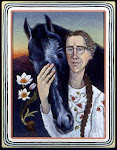(This is a post I started on several years ago, but never published.)
Don't stop reading aloud to your children just because they are old enough to read to themselves!
ACT data show that fewer than two in ten eighth graders are on
target to be ready for college-level work by the time they graduate
from high school. This means that more than eight of ten eighth-grade
students do not have the knowledge and skills they need to enter high
school and succeed there. And not surprisingly, our research shows that
students who are not prepared for high school are less likely than other
students to be prepared for college and career by the time they graduate
from high school...
In recent years, there has been heightened awareness of the importance of
early childhood education and high school as intervention points in the
educational lives of America’s children. Less attention, it seems, has been
paid to the importance of the upper elementary grades and middle school
and the role they must play in the preparation of students for life after
high school. - from "
The Forgotten Middle: Ensuring that All Students Are on Target for College and Career Readiness before High School", an ACT report. Full text available at http://www.act.org/research/policymakers/reports/ForgottenMiddle.html
The years between third grade and eighth grade are years your child should be soaking up information like a sponge (forgive the cliche!). Children should be reading independently, but they should also continue listening to you read aloud - often books that might be a stretch for them to read on their own. Ideally, children will re-read, on their own, books they have heard you read. This is NOT wasted time. Remember the research that found that the most effective way to improve reading fluency is to RE-READ.
Disasters - the human fascination with things gone wrong and nature's power begins early. When I started work on this post, my three-year-old nephew was into volcanoes. Of course you don't want to frighten children. Books are better than movies - you can stop to go over the most interesting or confusing parts, talk about it, edit it to make it suit the age or interests of the child, and you can always just close the book.
In no particular order, here are a few books about disasters, natural or otherwise. Check the nonfiction sections of your library or bookstore for more about natural or historical disasters.
Dear Katie, the Volcano Is a Girl, by Jean George, illustrated by Powers - a gentle argument between grandmother and granddaughter, as grandmother explains the geological processes that cause volcanoes to erupt, and the little girl counters with the Hawaiian myth of Pele. (Early elementary and up - picturebook)
Volcanoes and Earthquakes, by Rose (DK Eyewitness Books) - Lots of spectacular pictures and information, for elementary and up readers/listeners. The "Eyewitness" series has excellent books about other nature and science topics.
Jumanji, by Van Allsburg - the Caldecott winner with the adventure board game that turns out to be real - complete with lions, a volcanic eruption, and other unexpected occurences - when the kids don't read the directions first. (Kindergarten & up, picturebook)
The Village of Round and Square Houses, by Grifalconi - an African village, where the tradition of women living in round houses and men in square houses originated after the nearby volcano erupted. (Picturebook, early elementary and up)
Forces of Nature: The Awesome Power of Volcanoes, Earthquakes, and Tornadoes, by Grace - A National Geographic book, with the outstanding photography you would expect - this book covers the work of some scientists studying these forces of nature as well as the disasters themselves. (Middle elementary and up).
Noah's Ark by Peter Spier - a nearly-wordless picture book with intricate, sometimes amusing, pictures illustrating the traditional Bible story of the flood. (Ages 3-K)
The Ballymara Flood: A Tale from Old Ireland by Stuart, Illustrated by Booth - a silly look at a town flooded when a bathtub runs over, told in verse (age 3-early elementary)
SOS Titanic by Bunting - historical fiction with a touch of romance - the main character is a 15-year-old boy, and we all know the main plot! (middle school up)
White Star: A Dog on the Titanic by Crisp - a dog story, AND a disaster! Sam is a 12-year-old doglover on the Titanic, and determined to save the dog he has befriended on the voyage. (fourth grade up)
 Today, another old favorite: "The Dormouse and the Doctor" by A. A. Milne, from his book When We Were Very Young. Younger children probably enjoy this mostly for the sound; as adults, we enjoy the irony.
Today, another old favorite: "The Dormouse and the Doctor" by A. A. Milne, from his book When We Were Very Young. Younger children probably enjoy this mostly for the sound; as adults, we enjoy the irony.

